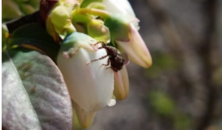
The 2019 Wine Grape Twilight Meetings are being held in South Jersey on Wednesday, May 22 and North Jersey on Thursday, May 23. See flyer for details. South Jersey: Wednesday, May 22; 5:00-7:30 PM William Heritage Winery 480 Mullica Hill Rd Mullica Hill, NJ North Jersey: Thursday, May 23; 5:00-7:30 PM Fox Hollow Vineyards 939 Holmdel Rd […]
Continue reading...
